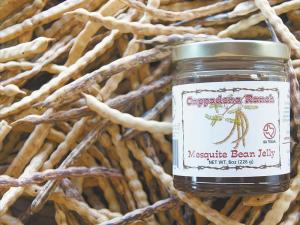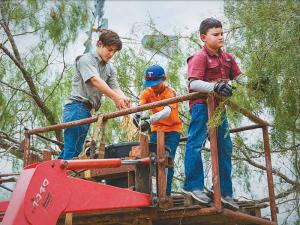2018 - Volume #42, Issue #2, Page #07
[ Sample Stories From This Issue | List of All Stories In This Issue | Print this story
| Read this issue]
They Don’t Hate Mesquite - They Eat It!
 |
 |
“To me it’s the wonder tree,” Cappadona says. “Native Americans thought of it as the tree of life; they used everything from its roots to its leaves. And bean pods are one of the most important parts.”
Older Texans recall as kids, chewing on mesquite bean pods for candy, and the sweetness is also appreciated by cattle and wildlife. More recent research classifies the bean pod as a superfood, high in fiber, calcium and iron with natural sugars. The mesquite bean pod has a low glycemic index, which is helpful for people with diabetes.
The Cappadonas own 5 acres of Honey Mesquite trees, and they have access to their extended family’s ranch with many more trees. When Cappadona and her husband and their three sons harvest the beans, they chew on a bean from each tree to make sure they’re sweet. They don’t pick from trees with bitter pods.
The beans are taken to a commercial kitchen and dried in ovens to store in food-grade barrels in an air-conditioned storage area until they are needed for orders.
Cappadona spent four years perfecting her mesquite bean jelly recipe. She boils the whole bean pod to infuse the flavor in water, then adds sugar, pectin and lemon. For a hotter jelly she adds chili pequin, which grows wild in Texas. Just 2 lbs. of mesquite beans yields 100 8-oz. jars of jelly that sell for $8/jar online.
Her second most popular item is mesquite bean coffee, which started as an accident when she was drying bean pods in the oven and the pods roasted too long. She knew Civil War soldiers made a coffee-like drink from the beans when coffee was scarce, so the Cappadonas ground the heavily roasted pods. It tastes very similar to coffee and appeals to people who can’t have caffeine.They also make tea from the seed, which is high in protein.
To make flour, the whole pods are ground very fine.
“It makes wonderful bread and pancakes,” Cappadona says, noting she has a great recipe for banana bread along with other recipes on her website. More recipes can be found in cook books that are published by Desert Harvesters (www.desertharvesters.org).
Contact: FARM SHOW Followup, Victoria Cappadona, Cappadona Ranch, P.O. Box 124, Linn, Texas 78563 (ph 956 867-1819; www.cappadonaranch.com; info@cappadonaranch.com).

Click here to download page story appeared in.

Click here to read entire issue
To read the rest of this story, download this issue below or click here to register with your account number.




